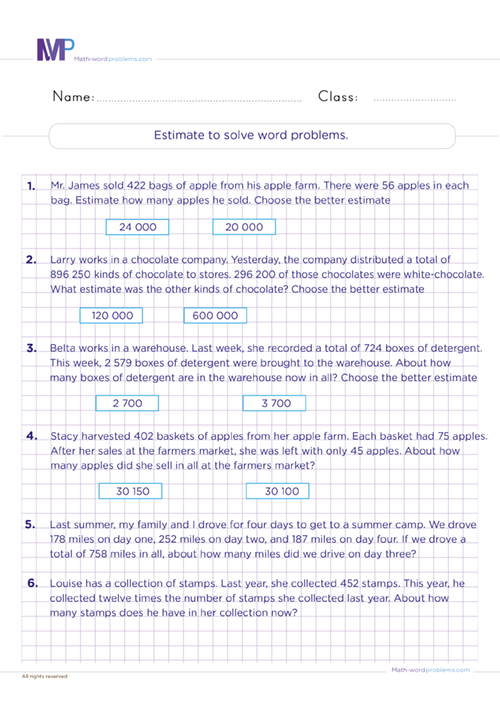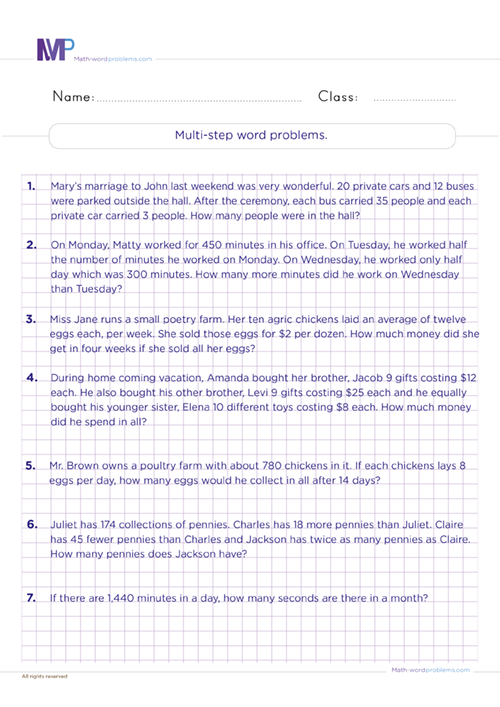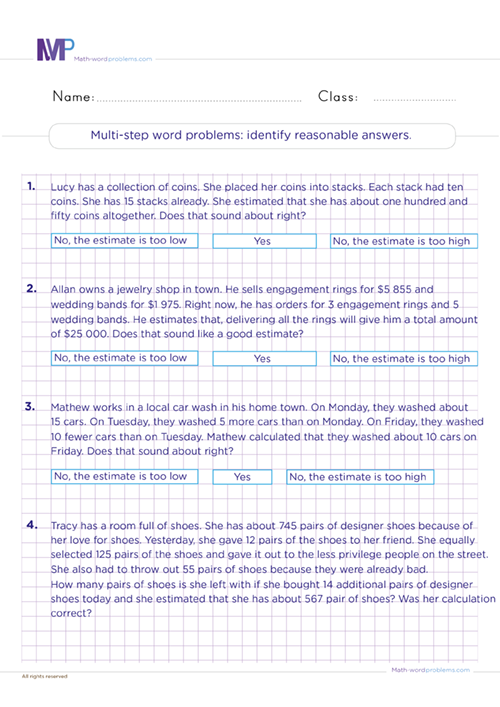 How do you do estimation word problems?
How do you do estimation word problems?
How do you do estimation word problems? Many kids want to find answers to this question. You will get them right here.
We will provide you with an efficient and effective way to accurately solve simple and complex estimation math word problems. Moreover, all the estimation problems designed for kids in this resource are very familiar and easy to understand. As such, they can easily identify keywords, then determine which math equation they need to solve.
Steps on how do you do estimation word problems
Let us find below here the steps on how do you do estimation word problems. These steps will help kids to discover how to solve estimation word problems in a very strategic and technical way. You'll find our fun strategies helpful in solving all tricky and challenging math word problems.
To illustrate to kids how straightforward and efficient these steps work, we have designed a few inspirational real-world examples with a coherent solving guide.
Step 1: IDENTIFY
Begin by reading out the word problem and even try to retell it in your own words. After that, try to figure out the important numbers and keywords in the word problem.
- Firstly, suppose it is estimating whole numbers involving addition word problems, you will see at least one of the keywords below: - add, plus, more, total, increase, together, Altogether, combined, sum, grow, join, both, in all, and, how many in all, how much, spend in all, etc.
- Secondly, suppose it is estimating whole numbers involving subtraction word problems, you will come across one of the keywords below in the word problem: - less, minus, take away, left, decrease, difference, fewer, deduct, remain, change, how many more, leftover, less than, how much longer/shorter, how much more, fewer than, discount, etc.
- Thirdly, if it is estimating whole numbers involving multiplication word problems, expect to see at least one of the following keywords in the word problem: - times, multiplied by, product, product of, factor, of, multiply, times, multiple, double, triple, groups, by, twice, area, equal groups, every, in all, total, increased by, as much, each, lots of, groups of, per, etc.
- Fourthly, suppose it is estimating whole numbers involving division word problems, you will see at least one of the keywords below in the word problem: - divide, half, evenly, every, per, parts, out of, quotient of, ratio of, how many in each, equal parts, cut up, average, as much, etc.
- Finally and most importantly, there are two ways to formulate or know if a word problem requires you to estimate. If you find these words like "about…" and "estimate …" in a word problem, then it is an estimation problem.
- Also, you have to know and understand place values.
- Furthermore, you have to know when to round up or down.
Note: One key Element for learners to understand is that they should not always rely on keywords alone. That is to say; the same keyword can have different meanings in different word problems.
For this reason, we reiterate on the importance of reading the question very carefully to understand the situation that the word problem is describing, then figure out exactly which operation to use
Step 2: STRATEGIZE
How will you solve or tackle the word problem?
- As mentioned above, from the keyword(s) in the word problem, you will know if you need to add, subtract, multiply or divide.
- However, it would be best if you do not count only on keywords; instead, try to understand the problem's situation.
- Furthermore, after knowing which operation you will perform, Construct short expressions/sentences to represent the given word problem.
Step 3: SET UP
Here, you are expected to write down a numerical expression representing the information in the word problem.
Step 4: PROVIDE A SOLUTION
From Step 3 above, estimate and add, subtract, multiply or divide the whole numbers depending on the operation the problem calls for. Always remember to add the unit of measurement to your final answer, if any.
Note that there are a few steps to follow when estimating or rounding.
- First, look at the number to the immediate right of the digit to be rounded.
- Then, if that number is 0−4, keep the digit to be rounded the same and replace all numbers to the right of that digit with 0
- However, if that number is 5−9, increase the digit to be rounded by 1 and replace all numbers to the right of that digit with 0.
Step 5: CHECK YOUR WORK
Finally, ask yourself this question. Does my answer make sense? If “YES”, you are done. If “NO”, go back to step 1 and start all over again.
Examples on how to solve estimation word problems
Example one: Here is an example on how to estimate subtraction word problems.
Step 1: First, the important numbers here are 524 and 98. Also, the keyword(s) found in the word problem is "left."
Step 2: Next, how will you solve the problem? As seen above, the situation that the word problem is describing and its keyword require you to perform a subtraction operation. Also, the phrase "about" tells you that you have to estimate.
Now, after knowing which operation you will perform, construct short expressions/sentences to represent the given word problem.
- Items on the shopping list that I had to buy = 524.
- Number of items on the shopping list that I bought = 98.
- Therefore, the estimated number of items I am left with to buy = Items on the shopping list that I had to buy – the number of items on the shopping list that I bought.
Step 3:Now, write down a numerical expression to represent the bolded sentence in step 2 above:
524 – 98 = ?
Step 4: From step 3 above, estimate and subtract the whole numbers by following the steps below using any method of your choice, preferably the column method.
- Frist, look at the number to the immediate right of the digit to be rounded.
- Then, if that number is 0−4, keep the digit to be rounded the same and replace all numbers to the right of that digit with 0
- However, if that number is 5−9, increase the digit to be rounded by 1 and replace all numbers to the right of that digit with 0.
- In addition, do not forget the unit of measurement, if any.
** take note of this very vital part. Since the subtrahend has only two digits, you have to round it to the nearest tens. Also, round the minuend to the nearest tens.
This is done only in cases where the rounding place for each number is not specified.
For instance, in this very problem, you might be asked to round the minuend to the nearest hundreds and the subtrahend to the nearest tens **
So, I am left with about 420 items to buy on the shopping list.
Step 5: Finally, check your work – Ask yourself this question. "Does my answer make sense?" If "YES," you are done. If "NO," go back to step 1 and start all over again.
Example two: How to estimate addition word problems
Step 1: After reading the problem with care, you will realize that the important numbers are $478,521,200, $999,561,870, and $574,001,000. You can also see that the keyword(s) found in the word problem is "total."
Step 2: Next, how will you solve the problem? Looking at the situation that the word problem is describing and the keyword found in the word problem, you need to perform an addition operation. Additionally, the phrase "about" tells you that you have to estimate.
Now, form short expressions/sentences to represent the given word problem.
- Amount of money Sarah deposited in the bank yesterday = $478,521,200
- Amount of money she deposited in the bank today morning = $999,561,870
- Amount of money she deposited in the bank today evening = $574,001,000
- Therefore, the estimated amount of money she has in the bank = Amount of money she deposited in the bank yesterday + the amount she deposited in the bank today morning + the amount she deposited in the bank today evening.
Step 3:After that, write down a numerical expression to represent the bolded sentence in step 2 above:
$478,521,200 + $999,561,870 + $574,001,000 = ?
Step 4: Then, from step 3 above, estimate and add the whole numbers by following the steps below.
- Frist, look at the number to the immediate right of the digit to be rounded.
- Then, if that number is 0−4, keep the digit to be rounded the same and replace all numbers to the right of that digit with 0
- However, if that number is 5−9, increase the digit to be rounded by 1 and replace all numbers to the right of that digit with 0.
- In addition, do not forget the unit of measurement, if any.
SSo, he has about $2,100,000,000 in the bank.
Step 5: Finally, check your work – Ask yourself this question. "Does my answer make sense?" If "YES," you are done. If "NO," go back to step 1 and start all over again.
Example three: Here is how to solve division word problems.
Step 1: From the question above, the important numbers are $455,550 and $772. Also, the keyword(s) found in the word problem is "each" and "how many."
Step 2: Now, how will you solve the problem? From the keywords and the situation that the word problem is describing, it shows that you need to perform a division operation. Additionally, the phrase "about" tells you that you have to estimate.
After knowing which operation you will perform, construct short expressions/sentences representing the given word problem.
- Amount of money he has to stock his new laptops = $455,550
- Cost of each laptop = $772
- Therefore, the estimated number of laptops that he will be able to buy = the amount of money he has to stock his new laptops ÷ the cost of each laptop
Step 3:Next, write down a numerical expression to represent the bolded sentence in step 2 above:
$455,550 ÷ $772 = ?
Step 4: From step 3 above, estimate and divide the whole numbers by following the steps below.
- Frist, look at the number to the immediate right of the digit to be rounded.
- Then, if that number is 0−4, keep the digit to be rounded the same and replace all numbers to the right of that digit with 0
- However, if that number is 5−9, increase the digit to be rounded by 1 and replace all numbers to the right of that digit with 0.
- In addition, do not forget the unit of measurement, if any.
**Again, take note of this very vital part. Since the divisor has only three digits, you have to round it to the nearest hundreds while rounding the dividend to the nearest hundreds too.
This is done only in cases where the rounding place for each number is not specified. **
$455,550 ÷ $772 ≈ $456,000 ÷ $800 = 570
So, he will be able to buy about 570 laptops
Step 5: Finally, check your work – Ask yourself this question. "Does my answer make sense?" If "YES," you are done. If "NO," go back to step 1 and start all over again.
Example four: Here is how to solve multiplication word problems.
Step 1: First, the important numbers here are 57,210 and 3. Also, the keyword(s) found in the word problem is "how many" and "thrice."
Step 2: Next, how will you solve the problem? The situation that the word problem describes and the keyword found in the word problem indicates that you must perform a multiplication operation. Additionally, the phrase "about" tells you that you have to estimate.
After knowing which operation you will perform, construct short expressions/sentences representing the given word problem.
- Quantity of ground beef the supermarket sold on Saturday = 57,210 pounds
- Quantity of ground beef they sold on Sunday than on Saturday = thrice the quantity they sold on Saturday.
- Therefore, the actual estimated quantity of beef that they sold on Sunday = the quantity of ground beef the supermarket sold × the quantity of ground beef sold on Sunday than on Saturday.
Step 3:Then, write down a numerical expression to represent the bolded sentence in step 2 above:
57,210 × 3 = ?
Step 4: From step 3 above, estimate and multiply the whole numbers by following the steps below.
- Frist, look at the number to the immediate right of the digit to be rounded.
- Then, if that number is 0−4, keep the digit to be rounded the same and replace all numbers to the right of that digit with 0
- However, if that number is 5−9, increase the digit to be rounded by 1 and replace all numbers to the right of that digit with 0.
- In addition, do not forget the unit of measurement, if any.
57,210 × 3 ≈ 60,000 × 3 = 180,000
So, the supermarket sold about 180,000 pounds of ground beef on Sunday.
Step 5: Finally, check your work – Ask yourself this question. "Does my answer make sense?" If "YES," you are done. If "NO," go back to step 1 and start all over again.






